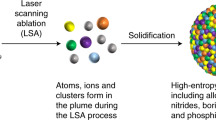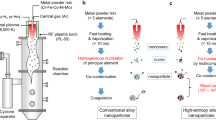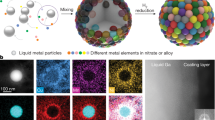Abstract
Subnanoscale (<2 nm) high-entropy alloys (SHEAs) have garnered increasing attention for their unique physicochemical properties that enable high catalytic performance. However, this potential is offset by reduced stability, a characteristic typically associated with high-entropy alloys, due to their high reactivity at this scale. Here we circumvent this obstacle by using the localized surface plasmon resonance effect along with laser fragmentation in liquids for synthesizing SHEAs. Localized-surface-plasmon-resonance-generated hot electrons from gold nanoparticles facilitate metal ion reduction, whereas the 7-ns laser pulse induces ultrafast heating and cooling cycles, fusing multiple metals into SHEAs with enhanced stability. This method enables the incorporation of up to ten elements into SHEAs. The selected AuPtRuRhIr SHEAs demonstrate high stability to work under 2 A cm−2 at 2.12 V for over 1,200 h in a proton exchange membrane electrolyser. This work presents a general strategy for the preparation of SHEAs, applicable across a wide range of fields.
This is a preview of subscription content, access via your institution
Access options
Access Nature and 54 other Nature Portfolio journals
Get Nature+, our best-value online-access subscription
$32.99 / 30 days
cancel any time
Subscribe to this journal
Receive 12 print issues and online access
$259.00 per year
only $21.58 per issue
Buy this article
- Purchase on SpringerLink
- Instant access to full article PDF
Prices may be subject to local taxes which are calculated during checkout




Similar content being viewed by others
Data availability
All data used for this study are available in the ScienceDB repository at https://doi.org/10.57760/sciencedb.29049 (ref. 57). Source data are provided with this paper.
References
George, E. P., Raabe, D. & Ritchie, R. O. High-entropy alloys. Nat. Rev. Mater. 4, 515–534 (2019).
Yao, Y. et al. High-entropy nanoparticles: synthesis-structure property relationships and data-driven discovery. Science 376, eabn3103 (2022).
Yeh, J. W. et al. Nanostructured high-entropy alloys with multiple principal elements: novel alloy design concepts and outcomes. Adv. Eng. Mater. 6, 299–303 (2004).
Sun, Y. F. & Dai, S. High-entropy materials for catalysis: a new frontier. Sci. Adv. 7, eabg1600 (2021).
Rao, Z. et al. Unveiling the mechanism of abnormal magnetic behavior of FeNiCoMnCu high-entropy alloys through a joint experimental-theoretical study. Phys. Rev. Mater. 4, 014402 (2020).
Liu, D. et al. Exceptional fracture toughness of CrCoNi-based medium- and high-entropy alloys at 20 kelvin. Science 378, 978–983 (2022).
Tao, L. et al. A general synthetic method for high-entropy alloy subnanometer ribbons. J. Am. Chem. Soc. 144, 10582–10590 (2022).
Luo, H. et al. Sub-2 nm microstrained high-entropy-alloy nanoparticles boost hydrogen electrocatalysis. Adv. Mater. 36, 2403674 (2024).
Feng, G. et al. Sub-2 nm ultrasmall high-entropy alloy nanoparticles for extremely superior electrocatalytic hydrogen evolution. J. Am. Chem. Soc. 143, 17117–17127 (2021).
Feng, G., Pan, Y., Su, D. & Xia, D. Constructing fully-active and ultra-active sites in high-entropy alloy nanoclusters for hydrazine oxidation-assisted electrolytic hydrogen production. Adv. Mater. 36, 2309715 (2024).
Minamihara, H. et al. Continuous-flow reactor synthesis for homogeneous 1 nm-sized extremely small high-entropy alloy nanoparticles. J. Am. Chem. Soc. 144, 11525–11529 (2022).
Troparevsky, M. C., Morris, J. R., Kent, P. R. C., Lupini, A. R. & Stocks, G. M. Criteria for predicting the formation of single-phase high-entropy alloys. Phys. Rev. X 5, 011041 (2015).
Chen, P. C. et al. Polyelemental nanoparticle libraries. Science 352, 1565–1569 (2016).
Zhao, P. et al. Facile and general method to synthesize Pt based high-entropy-alloy nanoparticles. ACS Nano 16, 14017–14028 (2022).
Li, Y. et al. High-entropy-alloy nanoparticles with enhanced interband transitions for efficient photothermal conversion. Angew. Chem. Int. Ed. 60, 27113–27118 (2021).
Li, M. et al. High-entropy alloy electrocatalysts go to (sub-)nanoscale. Sci. Adv. 10, eadn2877 (2024).
Hao, J. et al. Unraveling the electronegativity-dominated intermediate adsorption on high-entropy alloy electrocatalysts. Nat. Commun. 13, 2662 (2022).
Fan, L. et al. High entropy alloy electrocatalytic electrode toward alkaline glycerol valorization coupling with acidic hydrogen production. J. Am. Chem. Soc. 144, 7224–7235 (2022).
Cao, G. et al. Liquid metal for high-entropy alloy nanoparticles synthesis. Nature 619, 73–77 (2023).
Gao, S. et al. Synthesis of high-entropy alloy nanoparticles on supports by the fast moving bed pyrolysis. Nat. Commun. 11, 2016 (2020).
Yao, Y. et al. Carbothermal shock synthesis of high-entropy-alloy nanoparticles. Science 359, 1489–1494 (2018).
Liao, Y. et al. High-entropy-alloy nanoparticles with 21 ultra-mixed elements for efficient photothermal conversion. Natl Sci. Rev. 9, nwac041 (2022).
Frias, J. et al. Generation of nanomaterials by reactive laser-synthesis in liquid. Sci. China Phys. Mech. Astron. 65, 274202 (2022).
Zhang, D., Gokce, B. & Barcikowski, S. Laser synthesis and processing of colloids: fundamentals and applications. Chem. Rev. 117, 3990–4103 (2017).
Huang, H. & Zhigilei, L. V. Atomistic view of laser fragmentation of gold nanoparticles in a liquid environment. J. Phys. Chem. C 125, 13413–13432 (2021).
Ziefuß, A. R. et al. Laser fragmentation of colloidal gold nanoparticles with high-intensity nanosecond pulses is driven by a single-step fragmentation mechanism with a defined educt particle-size threshold. J. Phys. Chem. C 122, 22125–22136 (2018).
Amans, D., Diouf, M., Lam, J., Ledoux, G. & Dujardin, C. Origin of the nano-carbon allotropes in pulsed laser ablation in liquids synthesis. J. Colloid Interface Sci. 489, 114–125 (2017).
Shih, C., Wu, C., Shugaev, M. V. & Zhigilei, L. V. Atomistic modeling of nanoparticle generation in short pulse laser. J. Colloid Interface Sci. 489, 3–17 (2017).
Ziefuss, A. R. et al. Photoluminescence of fully inorganic colloidal gold nanocluster and their manipulation using surface charge effects. Adv. Mater. 33, 2101549 (2021).
Brandiele, R. et al. Laser-optimized Pt-Y alloy nanoparticles embedded in Pt-Y oxide matrix for high stability and ORR electrocatalytic activity. J. Energy Chem. 92, 508–520 (2024).
Chen, C. et al. Ruthenium-based single-atom alloy with high electrocatalytic activity for hydrogen evolution. Adv. Energy Mater. 9, 1803913 (2019).
Bongiovanni, G. et al. The fragmentation mechanism of gold nanoparticles in water under femtosecond laser irradiation. Nanoscale Adv. 3, 5277–5283 (2021).
Li, Z. et al. Co3O4 nanoparticles with ultrasmall size and abundant oxygen vacancies for boosting oxygen involved reactions. Adv. Funct. Mater. 29, 1903444 (2019).
Nag, A., Nguyen, C. M. & Tibbetts, K. M. Heterogeneous to homogeneous Cu–Ag nanoparticles by laser reduction in liquid. Appl. Surf. Sci. 610, 155384 (2023).
Tahir, S. et al. Synthesis of high entropy alloy nanoparticles by pulsed laser ablation in liquids: influence of target preparation on stoichiometry and productivity. ChemNanoMat 10, e202400064 (2024).
Waag, F. et al. Kinetically-controlled laser-synthesis of colloidal high-entropy alloy nanoparticles. RSC Adv. 9, 18547–18558 (2019).
Wang, B. et al. General synthesis of high-entropy alloy and ceramic nanoparticles in nanoseconds. Nat. Synth. 1, 138–146 (2022).
Govorov, A. O., Zhang, H., Demir, H. V. & Gun’ko, Y. K. Photogeneration of hot plasmonic electrons with metal nanocrystals: quantum description and potential applications. Nano Today 9, 85–101 (2014).
Manjavacas, A., Liu, J. G., Kulkarni, V. & Nordlander, P. Plasmon-induced hot carriers in metallic nanoparticles. ACS Nano 8, 7630–7638 (2014).
Brongersma, M. L., Halas, N. J. & Nordlander, P. Plasmon-induced hot carrier science and technology. Nat. Nanotechnol. 10, 25–34 (2015).
Hoggard, A. et al. Using the plasmon linewidth to calculate the time and efficiency of electron transfer between gold nanorods and graphene. ACS Nano 7, 11209–11217 (2013).
He, N. et al. Surface-plasmon-mediated alloying for monodisperse Au–Ag alloy nanoparticles in liquid. Inorg. Chem. 61, 12449–12457 (2022).
Li, J., Fang, Q., Liu, B., Liu, Y. & Liu, Y. Atomic-scale analysis of nanoindentation behavior of high-entropy alloy. J. Micromech. Mol. Phys. 1, 1650001 (2016).
Qi, Y., He, T. & Feng, M. The effect of Cu and Mn elements on the mechanical properties of single-crystal CoCrFeNi-based high-entropy alloy under nanoindentation. J. Appl. Phys. 129, 195104 (2021).
Mo, J. et al. Discovery of true electrochemical reactions for ultrahigh catalyst mass activity in water splitting. Sci. Adv. 2, e1600690 (2016).
Li, Y. et al. In-situ investigation and modeling of electrochemical reactions with simultaneous oxygen and hydrogen microbubble evolutions in water electrolysis. Int. J. Hydrogen Energy 44, 28283–28293 (2019).
Luo, Y., Zhang, Z., Chhowalla, M. & Liu, B. Recent advances in design of electrocatalysts for high-current-density water splitting. Adv. Mater. 34, 2108133 (2022).
Wen, Q. et al. Ultrahigh-current-density and long-term-durability electrocatalysts for water splitting. Small 18, 2104513 (2022).
Wang, W. et al. Insights into the rapid two-phase transport dynamics in different structured porous transport layers of water electrolyzers through high-speed visualization. J. Power Sources 516, 230641 (2021).
Ding, L. et al. Highly porous iridium thin electrodes with low loading and improved reaction kinetics for hydrogen generation in PEM electrolyzer cells. ACS Appl. Mater. Interfaces 15, 24284–24295 (2023).
Kresse, G. & Joubert, D. From ultrasoft pseudopotentials to the projector augmented-wave method. Phys. Rev. B 59, 1758–1775 (1999).
Blöchl, P. E. Projector augmented-wave method. Phys. Rev. B 50, 17953–17979 (1994).
Perdew, J. P., Burke, K. & Ernzerhof, M. Generalized gradient approximation made simple. Phys. Rev. Lett. 77, 3865–3868 (1996).
Grimme, S., Ehrlich, S. & Goerigk, L. Effect of the damping function in dispersion corrected density functional theory. J. Comput. Chem. 32, 1456–1465 (2011).
Nørskov, J. K. et al. Origin of the overpotential for oxygen reduction at a fuel-cell cathode. J. Phys. Chem. B 108, 17886–17892 (2004).
Nørskov, J. K. et al. Trends in the exchange current for hydrogen evolution. J. Electrochem. Soc. 152, J23 (2005).
Zhang, C. et al. Rapid synthesis of subnanoscale high-entropy alloys with ultrahigh durability. ScienceDB https://doi.org/10.57760/sciencedb.29049 (2025).
Acknowledgements
We thank the USTC Center for Micro- and Nanoscale Research and Fabrication for their support. This work is funded by the National Key R&D Program of China (2020YFA0406103 and 2022YFE0126500), the National Natural Science Foundation of China (21725102, 91961106, 22150610467 and 22232003), the Strategic Priority Research Program of CAS (XDPB14) and the Open Funding Project of National Key Laboratory of Human Factors Engineering (SYFD062010K).
Author information
Authors and Affiliations
Contributions
C.Z. and J.L. conceived the research and designed the experiments. C.Z., J.L., Y.B. and C. Liu performed the synthesis and characterization of samples and the measurements of HER and OER. C.Z. and C. Liang developed the LFL system. Z.W. performed the materials simulations. C.Z., J.L. and Y.X. analysed the data and wrote the manuscript. All authors discussed the results and commented on the manuscript.
Corresponding authors
Ethics declarations
Competing interests
The authors declare no competing interests.
Peer review
Peer review information
Nature Materials thanks Stephan Barcikowski and the other, anonymous, reviewer(s) for their contribution to the peer review of this work.
Additional information
Publisher’s note Springer Nature remains neutral with regard to jurisdictional claims in published maps and institutional affiliations.
Supplementary information
Supplementary Information
Supplementary Figs. 1–64, Tables 1–9, Notes 1–5 and refs. 1–60.
Supplementary Video 1
H2 bubble evolution during HER process on electrode.
Supplementary Video 2
O2 bubble evolution during OER process on electrode.
Source data
Source Data Fig. 1
Size distribution data plotted in Fig. 1f and XRD data plotted in Fig. 1h.
Source Data Fig. 3
MD simulations data plotted in Fig. 3.
Source Data Fig. 4
Electrochemical data plotted in Fig. 4.
Rights and permissions
Springer Nature or its licensor (e.g. a society or other partner) holds exclusive rights to this article under a publishing agreement with the author(s) or other rightsholder(s); author self-archiving of the accepted manuscript version of this article is solely governed by the terms of such publishing agreement and applicable law.
About this article
Cite this article
Zhang, C., Wang, Z., Liu, C. et al. Rapid synthesis of subnanoscale high-entropy alloys with ultrahigh durability. Nat. Mater. (2025). https://doi.org/10.1038/s41563-025-02358-9
Received:
Accepted:
Published:
DOI: https://doi.org/10.1038/s41563-025-02358-9



